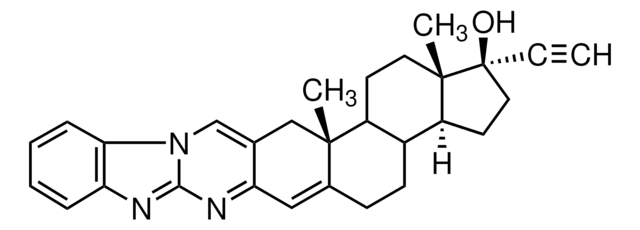C3118
CPNQ
≥98% (HPLC), solid
Sinonimo/i:
5-[4-(4-chlorobenzoyl)-1-piperazinyl]-8-nitroquinoline, B2
About This Item
Prodotti consigliati
Saggio
≥98% (HPLC)
Forma fisica
solid
Colore
brown
Solubilità
H2O: insoluble <2 mg/mL
DMSO: >5 mg/mL
Temperatura di conservazione
2-8°C
Stringa SMILE
[O-][N+](=O)c1ccc(N2CCN(CC2)C(=O)c3ccc(Cl)cc3)c4cccnc14
InChI
1S/C20H17ClN4O3/c21-15-5-3-14(4-6-15)20(26)24-12-10-23(11-13-24)17-7-8-18(25(27)28)19-16(17)2-1-9-22-19/h1-9H,10-13H2
KLNPVNZJCWIQSK-UHFFFAOYSA-N
Azioni biochim/fisiol
Altre note
Avvertenze
Danger
Indicazioni di pericolo
Consigli di prudenza
Classi di pericolo
Acute Tox. 3 Oral - Eye Irrit. 2 - Skin Irrit. 2 - STOT SE 3
Organi bersaglio
Respiratory system
Codice della classe di stoccaggio
6.1C - Combustible acute toxic Cat.3 / toxic compounds or compounds which causing chronic effects
Classe di pericolosità dell'acqua (WGK)
WGK 3
Punto d’infiammabilità (°F)
Not applicable
Punto d’infiammabilità (°C)
Not applicable
Dispositivi di protezione individuale
Eyeshields, Faceshields, Gloves, type P2 (EN 143) respirator cartridges
Certificati d'analisi (COA)
Cerca il Certificati d'analisi (COA) digitando il numero di lotto/batch corrispondente. I numeri di lotto o di batch sono stampati sull'etichetta dei prodotti dopo la parola ‘Lotto’ o ‘Batch’.
Possiedi già questo prodotto?
I documenti relativi ai prodotti acquistati recentemente sono disponibili nell’Archivio dei documenti.
Il team dei nostri ricercatori vanta grande esperienza in tutte le aree della ricerca quali Life Science, scienza dei materiali, sintesi chimica, cromatografia, discipline analitiche, ecc..
Contatta l'Assistenza Tecnica.






